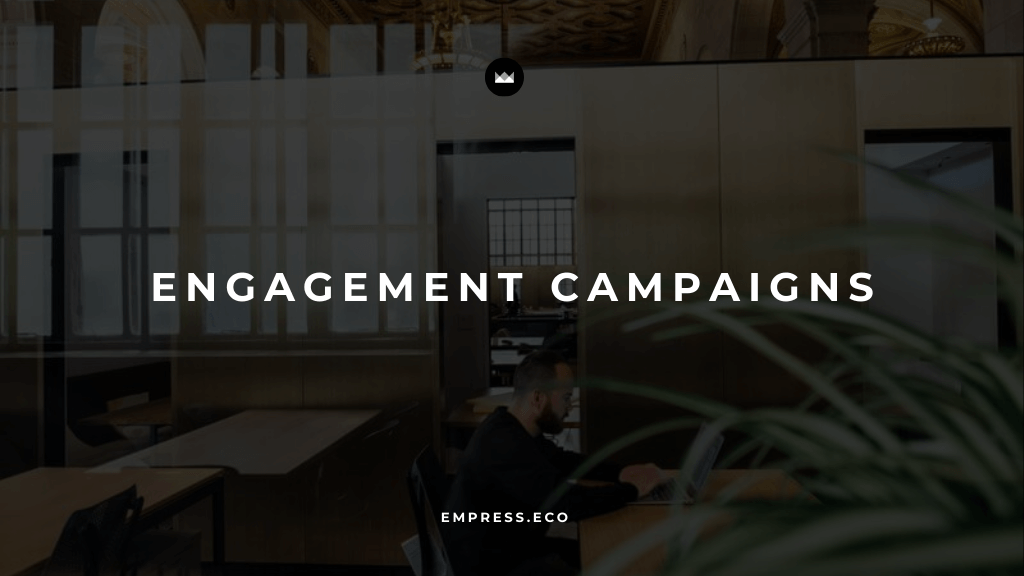
Engagement Campaigns: Launching Campaigns that Inspire Audience Loyalty
Table of Contents
Simply attracting customers isn't enough. The real challenge lies in turning those customers into loyal, long-term advocates for your brand. Engagement campaigns are designed to foster deeper connections between a brand and its audience, ultimately inspiring loyalty and building enduring relationships. These campaigns go beyond just promoting products; they focus on creating meaningful interactions that resonate with consumers, leading to stronger brand loyalty and sustainable growth.
Let’s dive into why engagement campaigns are so important, how to implement them effectively, and the challenges you might encounter along the way.
Why Engagement Campaigns Matter
Before we get into the strategies, it’s essential to understand why engagement campaigns are crucial for your brand's success. Think of engagement campaigns as the glue that holds your relationship with your customers together. While advertising might bring customers to your door, engagement campaigns keep them coming back, turning one-time buyers into repeat customers and loyal advocates.
Engagement campaigns are about creating a two-way conversation with your audience, making them feel valued and understood. These campaigns build trust and emotional connections, which are key to fostering loyalty. When done well, engagement campaigns can significantly enhance customer retention, boost brand advocacy, and create a community around your brand.
Key Benefits of Engagement Campaigns
To truly appreciate the power of engagement campaigns, let’s explore the key benefits they bring to your business.
1. Strengthened Customer Relationships
At the heart of any successful brand is a strong relationship with its customers. Engagement campaigns focus on building these meaningful interactions, which in turn lead to stronger relationships and increased loyalty. When customers feel that a brand genuinely values them, they are more likely to stay loyal, make repeat purchases, and recommend the brand to others.
For example, Starbucks’ Rewards program is a perfect illustration of how engagement campaigns can strengthen customer relationships. By offering personalized rewards and experiences, Starbucks keeps customers coming back, fostering a deep sense of loyalty.
2. Increased Brand Advocacy
One of the most powerful outcomes of engagement campaigns is the creation of brand advocates—satisfied customers who actively promote your brand through word-of-mouth and social sharing. These advocates not only help you reach new audiences but also enhance your brand's credibility, as recommendations from friends and family are often more trusted than traditional advertising.
Consider how Apple’s “Shot on iPhone” campaign turned its customers into brand advocates. By encouraging users to share their best photos taken with an iPhone, Apple not only engaged its audience but also created a powerful stream of user-generated content that showcased the quality of its products.
3. Enhanced Customer Insights
Engagement campaigns provide a wealth of valuable insights into customer preferences, behaviors, and feedback. These insights are crucial for informing future marketing strategies, product development, and customer service improvements. By understanding what resonates with your audience, you can tailor your offerings to better meet their needs and expectations.
For instance, Netflix uses engagement data to understand what types of content viewers prefer, which in turn informs their content creation and recommendation algorithms. This personalized approach not only enhances user satisfaction but also drives higher engagement and retention rates.
4. Higher Conversion Rates
An engaged audience is more likely to convert into paying customers. By maintaining ongoing communication and interaction, businesses can guide potential customers through the sales funnel more effectively, addressing their needs and concerns along the way. This leads to higher conversion rates and ultimately drives revenue growth.
For example, Sephora’s Beauty Insider program uses personalized engagement tactics—like tailored product recommendations and exclusive offers—to move customers from consideration to purchase, resulting in higher conversion rates and increased sales.
Implementing Effective Engagement Campaigns: A Step-by-Step Guide
Now that we understand the benefits, let’s walk through how you can implement engagement campaigns that inspire loyalty and build strong customer relationships.
Step 1: Personalize Interactions
In today’s market, customers expect personalized experiences that cater to their individual preferences and needs. Personalizing your interactions with customers makes them feel valued and understood, which is key to building loyalty.
Here’s how to personalize your engagement campaigns:
- Leverage Customer Data: Use data from previous interactions, purchase history, and behavioral analytics to tailor your messaging and offers. For example, you might send personalized product recommendations based on a customer’s browsing history or purchase patterns.
- Segment Your Audience: Divide your audience into segments based on demographics, behavior, or preferences. This allows you to create targeted campaigns that resonate more deeply with each group.
- Use Personalized Content: Personalize the content you share with each customer. This could include using their name in emails, sending birthday offers, or providing exclusive content that aligns with their interests.
For example, Amazon excels at personalization by using customer data to recommend products that users are likely to be interested in. This personalized approach not only enhances the shopping experience but also drives repeat purchases.
Step 2: Leverage Social Media
Social media is a powerful tool for real-time engagement and community building. It provides a platform for interactive and shareable experiences, allowing you to connect with your audience on a personal level.
Here’s how to use social media in your engagement campaigns:
- Encourage User-Generated Content (UGC): Create campaigns that encourage your audience to share their own content related to your brand. UGC not only boosts engagement but also provides social proof that can attract new customers.
- Host Live Events and Q&A Sessions: Use live streaming features on platforms like Instagram, Facebook, or YouTube to host events, tutorials, or Q&A sessions. This real-time interaction allows you to engage directly with your audience and build a stronger connection.
- Respond to Comments and Messages: Engage with your audience by responding promptly to comments and messages. This shows that you value their input and are committed to building a relationship.
For instance, Glossier’s approach to social media engagement involves regularly reposting UGC and interacting with customers directly on platforms like Instagram. This strategy not only drives engagement but also strengthens the sense of community around the brand.
Step 3: Offer Exclusive Content and Rewards
One of the most effective ways to inspire loyalty is by offering exclusive content and rewards to your most engaged customers. This can include early access to new products, special discounts, or a loyalty program that rewards repeat purchases.
Here’s how to implement exclusive offers in your engagement campaigns:
- Create a Loyalty Program: Develop a loyalty program that rewards customers for their repeat business. Offer points for purchases, referrals, and social media shares, which can be redeemed for discounts, free products, or exclusive experiences.
- Provide Early Access: Offer your most loyal customers early access to new products, sales, or content. This makes them feel valued and gives them a reason to stay engaged with your brand.
- Share Exclusive Content: Provide access to exclusive content such as behind-the-scenes videos, expert advice, or special tutorials. This content should offer additional value that your general audience doesn’t receive.
For example, Nike’s membership program, NikePlus, offers members exclusive access to products, events, and content, making them feel like part of an elite community. This approach not only drives engagement but also fosters a deep sense of loyalty.
Step 4: Encourage Two-Way Communication
Engagement is not just about broadcasting your message—it’s about creating a dialogue with your audience. Encouraging two-way communication builds trust and makes customers feel heard, which strengthens their relationship with your brand.
Here’s how to foster open dialogue in your engagement campaigns:
- Ask for Feedback: Regularly seek feedback from your customers through surveys, polls, or direct questions on social media. Use this feedback to improve your products, services, and customer experience.
- Host Q&A Sessions: Hold Q&A sessions where customers can ask questions about your products, services, or brand. This not only provides valuable information but also demonstrates your transparency and willingness to engage.
- Respond Promptly: Ensure that your customer service and social media teams respond promptly to inquiries and comments. Quick responses show that you value your customers’ time and are committed to meeting their needs.
For instance, Zappos is known for its exceptional customer service, which includes prompt responses to customer inquiries and a willingness to go above and beyond to meet customer needs. This level of engagement has helped Zappos build a loyal customer base that advocates for the brand.
Step 5: Create Compelling Storytelling
Storytelling is a powerful way to connect emotionally with your audience. Creating compelling stories that reflect your brand’s values and mission can inspire loyalty and deepen engagement.
Here’s how to use storytelling in your engagement campaigns:
- Highlight Customer Success Stories: Share stories of how your products or services have made a positive impact on your customers’ lives. These stories add authenticity and build trust in your brand.
- Share Your Brand’s Journey: Tell the story of your brand’s origins, mission, and values. This helps customers understand what your brand stands for and why they should support it.
- Use Visual and Emotional Elements: Combine visual elements like videos, images, and infographics with emotionally resonant narratives to create a compelling story that sticks with your audience.
For example, TOMS Shoes tells the story of how their “One for One” model helps those in need with every purchase. This narrative not only differentiates TOMS from other brands but also creates an emotional connection that inspires customer loyalty.
Challenges and Considerations in Engagement Campaigns
While engagement campaigns offer numerous benefits, there are challenges that businesses need to navigate to ensure success.
1. Resource Allocation
Developing and managing engagement campaigns can be resource-intensive, requiring time, budget, and personnel. Ensuring that these resources are effectively allocated is key to the campaign’s success.
To manage resource allocation:
- Set Clear Priorities: Focus your resources on the most impactful engagement strategies that align with your business goals. This might involve prioritizing certain platforms or types of content that yield the highest engagement.
- Automate Where Possible: Use marketing automation tools to streamline repetitive tasks, such as email marketing or social media posting. This frees up your team to focus on more strategic initiatives.
- Outsource When Needed: Consider outsourcing certain aspects of your engagement campaigns, such as content creation or social media management, to experts who can deliver high-quality results more efficiently.
2. Maintaining Authenticity
Authenticity is crucial in engagement campaigns. Customers can quickly detect when a brand is being insincere or disingenuous, which can erode trust and damage your reputation.
To maintain authenticity:
- Stay True to Your Brand Values: Ensure that your campaigns align with your brand’s core values and mission. Avoid campaigns that feel forced or out of character for your brand.
- Be Transparent: Be open and honest with your audience, especially when addressing challenges or mistakes. Transparency builds trust and strengthens relationships.
- Focus on Genuine Interactions: Prioritize real, meaningful interactions with your customers over scripted or automated responses. Authenticity shines through in genuine engagement.
3. Measuring Success
Evaluating the effectiveness of engagement campaigns can be complex, as success is not always measured by immediate sales. Businesses need to establish clear metrics to track engagement levels and assess the long-term impact of their campaigns.
To measure the success of your engagement campaigns:
- Set Specific Goals: Define what success looks like for your engagement campaign. Are you aiming for increased social media engagement, higher customer retention, or more brand advocates?
- Track Key Metrics: Use analytics tools to monitor key metrics such as engagement rates, customer feedback, social shares, and repeat purchases. These metrics provide insights into how well your campaign is performing.
- Analyze Long-Term Impact: Look beyond short-term results to assess the long-term impact of your campaigns on customer loyalty and brand advocacy. Consider using customer lifetime value (CLV) as a metric to gauge long-term success.
Conclusion: The Power of Engagement Campaigns
Engagement campaigns are a vital strategy for businesses looking to inspire audience loyalty and build lasting relationships. By creating campaigns that resonate with consumers and encourage interaction, companies can strengthen customer relationships, increase brand advocacy, and drive growth.
In summary:
- Strengthened customer relationships are achieved through meaningful interactions that foster loyalty and repeat business.
- Increased brand advocacy results from turning satisfied customers into vocal supporters of your brand.
- Enhanced customer insights provide valuable information for refining your marketing strategies and product offerings.
- Higher conversion rates are driven by engaging audiences and guiding them effectively through the sales funnel.
By following the steps outlined in this guide—personalizing interactions, leveraging social media, offering exclusive content and rewards, encouraging two-way communication, and creating compelling storytelling—you can launch engagement campaigns that not only inspire loyalty but also drive long-term success for your brand.
As the marketing landscape continues to evolve, engagement campaigns will be essential for businesses seeking to maintain a competitive edge and achieve sustained growth in today’s dynamic market.
Empress Newsletter
Join the newsletter to receive the latest updates in your inbox.



